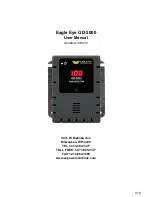
Hot Rocks and Mineralized Soils
Hot rocks
Iron rocks
Salty and alkali soils
0-5 / 95-99
5-25
25-35
Non-ferrous Metals
Gold nuggets and coins
Silver and lead
Brass and copper
Aluminum
54-89
80-95
90-97
93-97
Trash Metals
Iron, nuts and bolts, nails
Folio
Pull-tabs
Bottle caps
5-25
45-50
55-60
78-82
US Modern Coins
US 5 cent (nickel)
US 10 cent (dime)
US 25 cent (quarter)
56-58
84-86
88-92
Europe Modern Coins
10/20/50 Euro cent
1 Euro
2 Euro
81-82
83-85
74-75
As mentioned before, Target ID is a 2-digit number produced by the detector and it gives
you an idea about what the target may be. The number is displayed both on the LCD panel
and the numeric display on the handle.
Under certain conditions, the device may generate multiple IDs for the same target. There
may be a few reasons for this: target orientation, target depth, purity of metal, corrosion,
ground mineralization etc. Based on these factors, even the sweep direction may cause the
device to generate multiple IDs.
On the other hand, the device may not give any ID under some circumstances. For the
device to generate an ID, the target signal must be strong enough for signal processing.
Therefore, although it may detect very deep or small targets, it may not be able to generate
an ID.
In addition to the target ID, there is a color scale at the top of the LCD panel which
represents rocks, iron and metals encountered in the field. When a target is detected,
simultaneously with the display of the target ID, the target ID indicator (horizontal bar)
shows the color range corresponding to the detected target.
What you should keep in mind is that the target ID and colors are estimated values and
there is no way of knowing for sure what’s buried other than to dig it up.
Non-ferrous metals such as copper, aluminum, lead etc. have high IDs. The ID range of
gold, however, is broad and can fall in the same range with some trash metals such as iron,
folio, screw caps, and pull-tabs. Therefore, if you are looking for gold targets, digging out
some trash metals is expectable.
Probable IDs and ranges of some targets are shown in the table below:
FORS / Page 22
www.noktadetectors.com
NOKTA DETECTORS
TARGET ID and ID MASKING











































